Tilapia Culling Tips
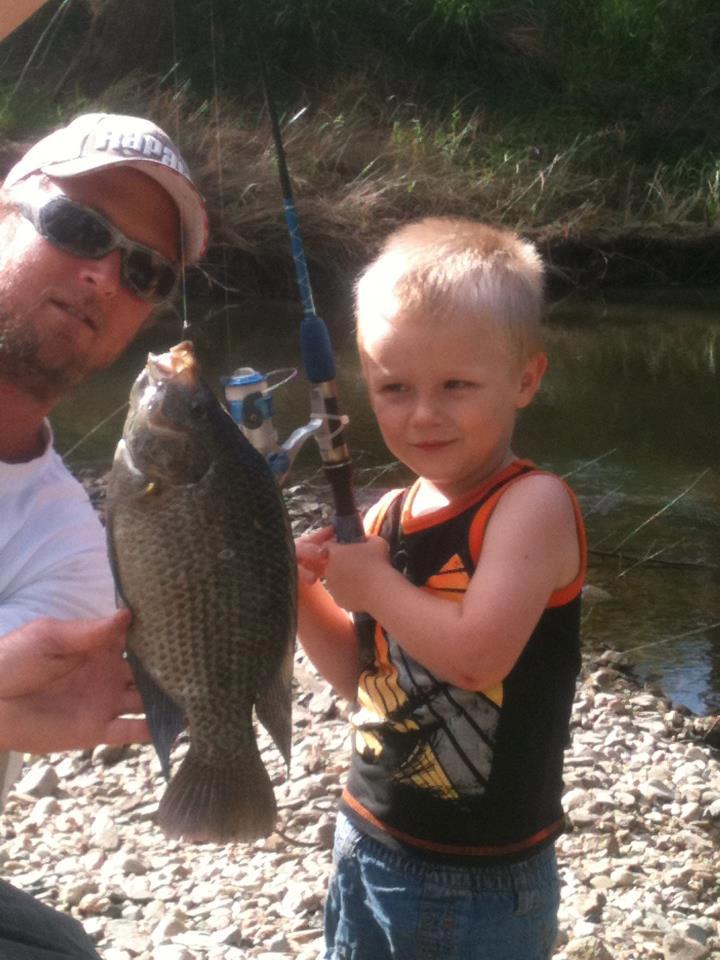
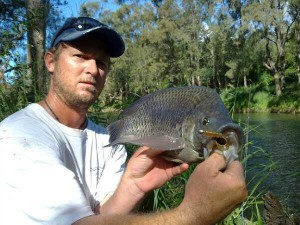
General Information
Scientific Name: Tilapia, Oreochromis and Sarotherodon spp.
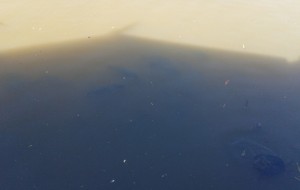
Tilapia Overview
Tilapia live in our freshwater ecosystems, but can also tolerate water that contains low levels of salt. Tilapia prefer warmer water temperatures such as our Queensland Fresh Waterways where they breed uninterrupted. Since the introduction into our waterways, Tilapia have become problematic invasive species and populations have flourished to a point where our Native Species are placed in danger of being wiped out in certain areas.
Large individuals have been reported to prey on small fish and occasionally cannibalize their own young if food is scarce of if the young are not quick enough to leave the males area.
Tilapia are readily caught as a by-catch by fishermen targeting species such as Australian Bass, Spangled Perch, Freshwater Mullet & Gar.
Angler interest in tilapia has spiked with the Call to Arms in the attempt to stem the spread of this noxious pest. One good thing the Tilapia has going for it is the fight it puts up for fishermen using light tackle, it is a great Sports Fish for the whole family to enjoy!
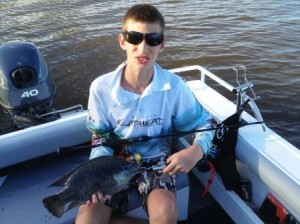
At the end of the day, Department of Agriculture, Fisheries and Forestry consider them invasive species and we all must treat them as such. Unfortunately the following is the hard and fast fact:
“This fish is declared noxious in Queensland. It is unlawful to possess noxious fish alive or dead or to use them as bait. It is illegal to place or release noxious fish alive or dead into Queensland waterways. Penalties of up to $200,000 apply” This is a complete copy from the web site: http://www.daff.qld.gov.au/fisheries/pest-fish/noxious-fish/tilapia
Habitat
Adults thrive in shallow standing waters. Inhabit reservoirs, rivers, creeks, drains, swamps and tidal creeks; commonly over mud bottoms, often in well-vegetated areas. Also found in shallow warm weedy pools of sluggish streams, canals, and Lagoons. Most common in blind estuaries and coastal lakes, but usually absent from permanently open estuaries and open sea and from fast-flowing waters.
Tilapia have it over our Native Species, they will tolerate low dissolved oxygen levels which normally kills the local guys, Tilapia can utilize atmospheric oxygen when water oxygen levels drop.
Diet
Most of the Tilapia are known weed eaters and normally will not take baits presented by fishermen, however other species of the Tilapia family will readily take baits such as Garden Worms, Shrimp, Bread baits, insects and Corn!
Reproduction
It is no wonder that Tilapia take over the waterways, check out their breeding habits:
- Reach sexual maturity at 15 centimeter length, but stunted fish may breed at 6-7 centimeters and at an age of just over 2 months.
- Female Tilapia deposits 100-1700(1800) eggs and the males place their milt over them.
- Eggs and milt are sucked up by the female.
- Fertilization is reported to sometimes occur in the mouth of the female.
- Females incubate eggs alone.
- It is possible, albeit rare, that males take up some eggs after spawning, but they almost always eat them soon after.
- Females school together while mouth-brooding, they cease to feed and subsist on food reserves stored in their body.
- Females may spawn a full clutch with just one male, or may spawn with several different males in a series.
- Water is circulated over the eggs by chewing movements of the jaws.
- Fry hatch in the female’s mouth after 3-5 days, depending on the water temperature.
- The young are released from the mouth in 10-14 days, but remain near the female and enter the mouth if threatened until about 3 weeks old.
Catching Tilapia
Effectively we need to remove as many of these fish as we can from our waterways however we need to do it in the right way. The last thing we want is for people to receive hefty fines for breaching the Law.
Some things to remember:
- Check local Regulations regarding where you want to fish as some areas may have a “No Fish” rule in place.
- Check with the Property Owner if you plan on fishing on Private Property.
- Check if there is an allocated area to dispose of the Tilapia I.E Designated rubbish bin or an area where you can bury your Tilapia.
- The contact number for Wildlife Rescue 1300 264 625 just in case you find an injured Turtle, Platypus or other Wildlife.
- First Aid Kit as some areas you may visit will have Snakes and other Hazards!
- A Ruler or Truth Mat and a Camera so you keep a record of the Tilapia you have caught!
Now, if you have a set up ready to go fishing for Bream or Bass then you are ready to start culling a few Tilapia!
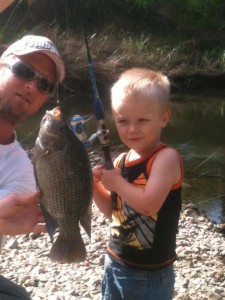
Prior Preparation
- Decide where you will go fishing. Tilapia prefers warm water that is either still or flows very slowly.
- Chose your area where you are going to land your fish, some areas may be covered in weed or grass which may hide things like logs, steep drop offs or other hazards which we forget to look for once we have hooked a fish!
- Keep an eye out for other wildlife like ducks and swans who will no doubt want some of the bait your using, particularly if you’re using Bread or a Dough mix!
- Chose your hooks carefully, you will need a small but strong hook a No6 Longshank Bait Holder Mustad is as good as any.
- Don’t forget to flatten the Barb down, this will make it very easy to remove the hook from not only the Tilapia but also things like Turtles, Mullet and other species.
- The use of a Float may also be helpful, this way if you’re fishing with the kids they will know for sure they have a bite rather than constantly pulling the line in to check! It also adds a bit of extra excitement seeing the float disappear..
- Burley, this can be very useful when bringing the fish to you, use small amounts and try to keep the size of Bread Burley around the same size you will be putting on your hook.
- If you are using baits such as Worms, Insects or Corn then you may not need the Burley.
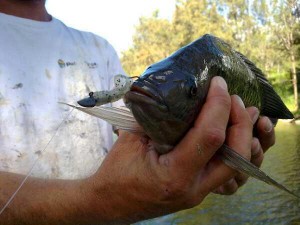
Rod & Reels
Some people make it a bit more interesting by using a “Pole” or simple Hand-line” but most prefer to stick with the standard “Spin” outfit.
As we said, a rod and reel combo used Bream or Bass will be fine for the job, generally a rod around the 6’-7’ and either 1-3kg up to 2-4kg. Graphite or Fiberglass will be fine, really it is whatever you would normally use.
With the Reel you can start with a 1000 series and work your way up to a 2500 series reel, anything over this will be overkill. However if your gear is larger like a 4000 – 6000 series reel, you don’t need to go out and buy another one which is smaller. The idea is to use what you have and enjoy the time!
Lines
If you want to add a bit of “Sport” to the occasion then drop your mainline down to a 3-6lb if you are using Braid or Fireline and about an 6-8lb if you are using Mono. Some of the Tilapia we have found are around the 2kg mark, so imagine the fight you will have on light gear!
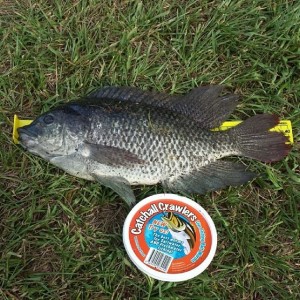 Baits
Baits
Tilapia can be rather picking on some days and will not touch a bait regardless of what you throw at them! Other days the will eat just about anything.
Some of the most effective baits used to date are:
- Garden Worms – Place the hook through the Worms Collar and then a couple of times through the body and you’re done.
- Live Shrimps – Best thing to do is catch them in location and use them live by putting the hook straight through the last segment nearest the tail and let it swim un-weighted.
- Frozen or Dead Shrimps – Rig them as you would a Prawn, removal of the head is optional, place the hook through the underneath of the tail and thread it back up towards the head, it should slide onto the hook effortlessly bringing the hook out just before the head.
- Crickets – dead or alive, place the hook through the body and send it out un-weighted for best results.
- Cicadas – Again just place the hook through the lower part of the body and send out un-weighted. Live Cicadas will make a commotion on top of the water and will bring in all types of predators!
- Dough Baits – If making a Dough bait be sure to add in a bit of Cotton Wool to help the mixture stay on the hook better. Mould the dough around the hook, the weight of the bait should be enough to allow for casting and should sink nice and slow for maximum effect.
- Bread Bait – Make sure your Bread Bait is about the same size as the bread you are using for Burley. Thread your hook through the Bread Bait the best you can and send it out un-weighted, be careful not to cast too hard as the Bead Bait and your hook will be easily separated!
- Corn Kernels – One of the easiest to use, simply place on 4-5 Kernels of Corn to your hook and let it rip! Corn is a very hard bait and it is also great bait for catching Carp (Another Noxious Species).
- Don’t forget to add a Bubble or Pencil Float to your rig, this will also give you a better casting weight if you are fishing un-weighted baits.

Lures
A lot of people believe that Tilapia will not take lure however they are known to attack other fish species. Z Man GrubZ, Berkley Shrimps and Isome Worms are just a couple of plastics which have lead to the demise of many Tilapia. Anything around the 2-3” range seem to be on the menu so don’t be afraid to get out there and test out your own collection, the results might just surprise you!
Small Shallow Divers and Vibes are also effective on Tilapia, fishermen chasing Bass and Yellowbelly sometimes end up with a fight on their hands once a Tilapia decides to strike their Jackal, Rapala, Maria or Atomic Hardz. Lures do not need to be expensive and after all you are going to be fishing in reasonably snaggy areas so be prepared to lose a couple of lures or be prepared to go for a swim.
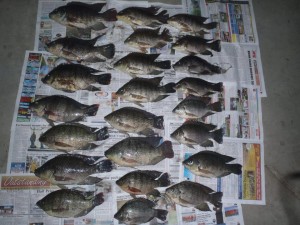
Disposal
When catching Tilapia we must be mindful of the Queensland Regulations and Legislation in place for the disposal of Noxious Species.
In a nutshell we are not permitted to remove Tilapia or any part of that Tilapia from the area of capture which includes the “Fillets”. Best advice is to place them in a bin, bury them or place them well away from the water but in the same location!
To avoid fines of up to $220,000 please follow the direction of Department of Agriculture, Fisheries and Forestry. I have included an extract from their page and the direct link is available at the bottom of this document.
What to do if you catch a Tilapia or Carp
If you catch a noxious fish, kill the fish as quickly and humanely as possible. The most appropriate method may involve stunning the fish via a sharp blow to the back of the head causing brain destruction.
It is an offence to have noxious fish (such as carp and tilapia) in your possession, either dead or alive (except dead Nile perch). You must therefore dispose of the fish as soon as practicable after killing. It is recommended that you do this by burying it a suitable distance from the waterway where it was caught or disposing of it in a rubbish bin.
Referenced Documents and Thanks
I would like to Thank Danielle from Department of Agriculture, Fisheries and Forestry who has helped out with some vital information regarding Tilapia and ultimately saving fishermen valuable money in unwanted fines!
While putting this document together I used snippets of information from the sites below. More comprehensive information is available from these sites so check them out if you get a chance or if you need more indepth information.
www.legislation.qld.gov.au/LEGISLTN/ACTS/1994/94AC037.pdf
www.daff.qld.gov.au/fisheries/pest-fish/noxious-fish/tilapia
www.daff.qld.gov.au/fisheries/pest-fish
www.fishbase.org/Summary/SpeciesSummary.php?ID=3&AT=tilapia
Add Your Information!
If you have any tips, locations or information you would like to share with other reader, please post your comments in the box below.
Maintain the Passion!

54 Comments
Not being able to utilize the fish as food is an incredibly stupid regulation.
Jeff we totally agree, in the right areas (Running freshwater) their meat is highly regarded!
Hey do u need to use a float or hook sinker and swivel to catch them
Hi Zane, I normally use a “Stick Float” which sits about 30cm above the baited hook. This length will vary depending on what depth they are feeding at. Sometimes if there are a few mullet being a pain I will use a small splitshot or small ball sinker to get it away from them! Hope this helps. Maintain the passion!
Totally agree and if tilapia is spreading so rapidly it’s because of this regulations.
They have done this to eliminate any commercial incentives that may encourage some to “farm” this species
You are correct Jeff, also to prevent people with dams and ponds from breeding them.
why oh why is it not eaten? fried, it tastes sweet and nice…what a waste of food. It’s not even poisonous!
Shirly, I agree that we should be able to take these fish home for the table however the authorities are concerned about spreading this invasive species into new areas where they can do serious damage. More local regulations need to be put in place where an area already severely infected can re-use the catch for food or even compost.
I think the whole idea is that the spawn don’t get released during the filleting process – being mouth spawners it would be difficult to try to get the majority of the population to ensure the fingerlings don’t go back into the waterways and pose a bigger threat to the native species 🙂
Krysal
with respect we are not talking about the majority of the population only those people who wish to catch tilapia for food. I think a good education program is required with signs on the rivers and creek and lakes. The strength of the tilapia is the mother mouth brooding. GO to your local creek and watch them then you will understand, get rid of the big females who are difficult to catch and you are on the way to success in dealing with tilapia
Please note the Greens dont care.
I fully agree with you. It’s a waste of food… while most are facing hunger and poverty, especially here in Africa. Can’t this “noxious” fish be exported to some poor nations around the world. After all it’s the eaten fish in the world
it is a pitty that in Aus you render the tilapia as a problem fish , in Africa we try to conserve the species , wonderfull fish to catch and great to eat . Bass compose a greater problem to other species . Tilapia should not be a problem . think again .
thanks
JJ
Thanks for your thoughts Johan, in Australia Tilapia are taking over and killing off native species at a great rate. We need to preserve our natives so strict laws are in place. They are a fantastic sports fish and are great on the table. Our natives need to take priority over an introduced species.
ME again , forgot to suggest fly fishing method to catch the Tilapia , great fun , try it and you`ll be surprised.
THE SPECIES IS CLEAN AND DOESN`T CARRY DISEASES .
please can you tell me what bait you use fore tilapia Alex from Brisbane
Hi Alex, we use everything from garden worms, corn and bread to catch these guys.
Thanks for the great info. Steak is another great bait to use. I usually use it when fishing in town and it stays on the hook, 4 tilapia on the same piece of bait is my record (yeah i’m a bit lazy) 3-4cm strips always try to get a bit of fat in it as that is what keeps it on the hook.
Myron, I must admit I have not tried Steak however this season I will slice a bit off before it goes in the pan!
Thank you for your suggestion.
It is a pity we cannot legally eat the tilapia as they are quite tasty when prepared properly. They are a major food fish in other parts of the world. In America they are being raised in fish culture situations as a project to feed third world countries. They have been present in our local dams well over 30 years. I can remember seeing some in north pine dam back in 1980. Not in large numbers at that time though. An old south African friend of mine used to catch hundreds on a dough bait mixed with a particular red wine. He would never tell anyone the actual brand of wine though!
Colin, I totally agree that the Tilapia should feature on the Menu! Hopefully the powers to be will soon see the value in this pest fish, just like the Charlie Carp!
You can legally eat tilapia as long as you have bought them from a shop etc. The draconian laws only apply to the fish that are caught by you (anglers). Before I go camping next week I may drop into the dodgy shop in Gatton and purchase some tilapia (checking the use by date naturally) to take with. I can then ponder on just how ludicrous the fisheries have become while I bar b que my shop bought tilapia on the shores of Lake Somerset only a few metre away from water that are supposed to be teeming with them but are untouchable.
Tilapia are one of the biggest consumed fish in the US and are raised in fish farms in Mexico. I have eaten them in PNG where they are usually smoked over a fire by the local villagers and sold in markets. Great food. It is a sad fact that they do terrorise our native fish populations and some effort must be put into eradicating them, but the horse has bolted I would venture to say. Let’s hope keeping the fillets can be legalised. Maybe strip the fillets and bbq them on the beach might be the way to go. Cheers.
Peter I totally agree! We should be able to have fillets in our possession but not the frame. Let’s hope the powers to be can see the sense in it..
HUNGRY JACKS ASPLEY in the drain creek.
Hi Neil, yes that is a great spot, we took Nick down there yesterday for his first time and we bagged a few nice ones!
I know this is an old article but is it legal to target tilapia as long as they are disposed of accordingly
GJ, Yes you are right, you can target Tilapia just so long as you dispose of them as soon as you can.
Hi I found a fb page that some ppl fish in the zillmere water holes. i wanna go have a crack just not sure if council actually allow it. and also were to dispose of them legally with out atracting a fine. kind regards
guy
Hi Guy, Yes you can fish in the Zillman Waterholes. All we do is put the ones we catch in a garbage bag after we brain spike them and then we take them and place in our bin. If you have council provided bins it is great however in most areas there is a lack of these bins.. We do ask that dead fish are not left laying around as this will attract unwanted exposure by the council.
Good luck and feel free to post up photos on the “Tilapia Files” FB page.
Hey,
I live in the Southside of Brisbane and was wondering where I could fish for these guys. Are there Tilapia in Bulimba Creek?
Btw nice article
Thank you
Hi Roshan, we have seen them in Bulimba Creek, we have not had a chance to fish for them there but we will be back ready to cull a few!
Hi! I haven’t gone fishing in any of the fishing spots here in Australia. I’m from the Philippines and am just on a visit here in your beautiful country. However, i’m greatly surprised that the tilapya is treated here as a noxious fish. In my country, this kind of fish is served on the table and you’ll be surprised to know that when properly done, all parts of the fish can be eaten, except for the scales. My only wish is that the people who catch tilapya here can be allowed to cook it right away in the fishing camp instead of throwing these away in the bin. I sincerely hope the higher officials will get to try and taste tilapya because it really is good to eat. Thank you so much for the time you spent reading this.
Hello Noemi, we agree with your thoughts, Tilapia should be allowed to be taken and eaten in location. However I can understand why they do not allow this. The concern is with infecting waterways that are Tilapia free. We hope that you have enjoyed your visit here and had a great time.
I live in the redlands on brisbane’s bayside and was wondering if there is anywhere local that I can fish for Tilapia?
Hi Damian, not sure where they are over your side of town but they are there! Google Maps to find your local freshwater and I am sure you will find them. You and also look on Facebook under “Pest Fish” as they cover your area. Good luck and happy hunting!
The lake behind buntings is teeming with them
Hi Derek good to know people are keeping an eye out for them, which Bunnings are you referring too?
Bunnings Capalaba
Cheers Calum! It would be prime time to hunt them now!
hey yeah Leslie Harrison dam though your not allowed to fish it it is crazy full of them last winter a lot of them died and seq water removed 5 tonnes of it there is also Coolynwynpin creek near the BCF they dont allways take your bait but if you jump the fence there is normally tonnes also indigiscapes theres some huge ones but idk if you can fish it
Great article thanks guys.
Thank you Michael, hopefully you are inspired to get out there and do some culling!
Tilapia will also eat pond scum to. At least the ones in Okinawa do.
What would be the best preffered lure for the talapia
Zander, Silver is a good colour as they are very territorial, a small shallow diver should work well.
Any particular retrieve when using hard bodies? constant retrieve? twitching with pauses? I live in Deagon, I’m a 100% lure angler and would love to clean the lagoons around the area that I know are infested with tilapia. I was thinking on using bait but if a lure of any kind can do a similar job I will definitely stick to that. I though insect-looking plastics would be my best bet but if hard bodied diving lures are effective this would allow me to cover more area in a quicker way…also wondering if the cicada lures I use for bass would also work (or poppers as I remember reading somewhere tilapia can be caught on surface lures?)…any advice will be greatly appreciated. The more successful I get the cleaner the lagoons in our area will get 😉
Oh, last question…is there a preferred time of the year for catching tilapia? And will they chase different type of lures depending on the time of the year?
Thanks for the article!! Cheers!
Hi Ramon, just found your message in the depths! just use the lures like you are chasing Bass and during there nesting season through a larger lure and work it around the nest, they are very aggressive and will attack any competition!
Plastics I would be using a very small paddle tail or a grub style. The bite best in the warmer months and shut down during Winter.
in tingalpa creek towards the dam wall there are plenty there about 40cm, the dam is also full of them but they are very picky with thier baits. i hada fresh peice of cut pilchard and i saw the fish just swim past it. some days they take meat the next day they wont, ive also caught them on lipless crank baits and other hard bodied lures
Hey Jack, they will take Vibes as well while they are in the nesting phase. Normally we just use Garden Worms and they can not resist!
Very good article..learned a lot from it …also the comments and answers were very useful..Im going Tilapia Busters tomorrow . Wish me luck 🙂 .
Thank you everyone.
Hey Nass, hope you had a great trip!
Tilapia skin has been used to great effect on severe burns
Hey Stan,
I watched a documentary in the same thing, amazing what the Tilapia Skin does with burns!
I wonder if they use it here?